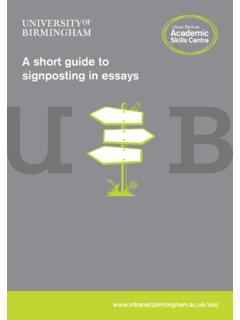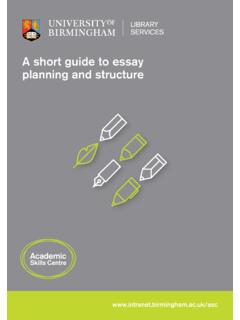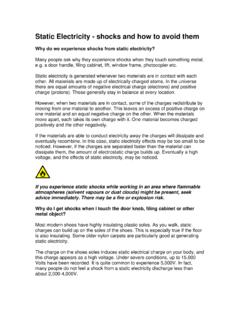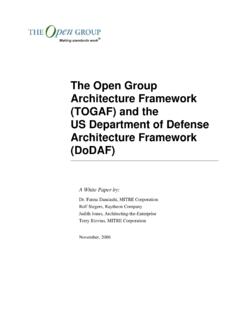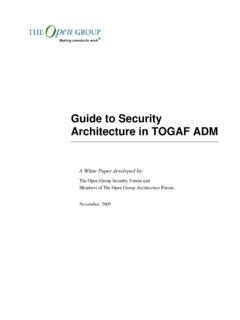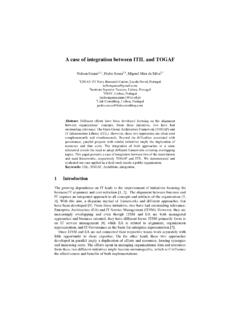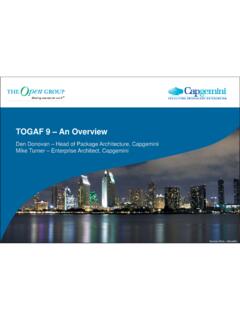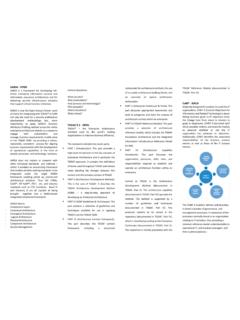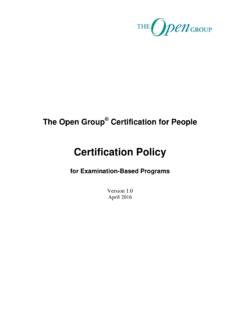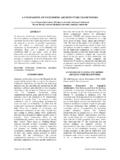Transcription of Enterprise Architecture Framework - University of Birmingham
1 open Enterprise Arch itect ure Framework IT Services / Enterprise Architecture / PUBLISHED / v Page 1 of 34 open Enterprise Arch itect ure Framework IT Services / Enterprise Architecture / PUBLISHED / v Page 2 of 34 Contents 1 Introduction .. 4 Background .. 4 Scope .. 4 Purpose .. 4 2 Framework Description .. 5 Architecture Process .. 5 Architecture Framework .. 7 Governance .. 8 Assurance .. 8 Project Implementation Assurance .. 8 Verification and Testing .. 9 Enterprise Architecture Principles .. 11 Principles .. 12 IT Strategy Drivers .. 15 Goals .. 15 Non-Functional Requirements .. 16 Architecture Team .. 17 3 Models .. 18 Business Layer .. 18 Business Capability Modelling .. 18 Information Management Life Cycle .. 19 Business Priority .. 19 Application Layer .. 20 Application Maps .. 20 Portfolio Management .. 21 Technology Layer.
2 22 Technical Reference Model (TRM) .. 22 Standards Information Base (SIB) .. 22 Verticals .. 23 Security Architecture .. 23 Data Architecture .. 23 Road Maps .. 23 Patterns .. 24 Glossary .. 25 References .. 25 APPENDIX A. Ontology .. 26 APPENDIX B. Standard Agenda for Architecture Compliance Reviews .. 28 APPENDIX C. Strategic Reference .. 29 APPENDIX D. Process Comparison .. 33 APPENDIX E. Archimate Diagram Notation Key .. 34 open Enterprise Arch itect ure Framework IT Services / Enterprise Architecture / PUBLISHED / v Page 3 of 34 Figures Figure 1 Enterprise Architecture .. 4 Figure 2 Architecture Process .. 5 Figure 3 Architecture Model Matrix .. 7 Figure 4 Governance Chart .. 8 Figure 5 Architectural Governance for Projects .. 9 Figure 6 Verification Diagram .. 10 Figure 7 Enterprise Architecture Principles .. 11 Figure 8 Architecture Team .. 17 Figure 9 Business Capability Modelling.
3 18 Figure 10 Business Capability Map .. 19 Figure 12 IMLC .. 19 Figure 11 Business Priority .. 20 Figure 13 Example Application Map .. 20 Figure 14 Evaluation Matrix .. 21 Figure 15 togaf Technical Reference 22 Figure 16 Example Road Map Gantt .. 23 Figure 17 System Life Cycle .. 24 Figure 18 Motivational View .. 29 Figure 19 Process Comparison .. 33 Figure 20 Key to Archimate Diagrammatic Notation .. 34 Document Control Version Author Description Date David Deighton First published edition 17/09/11 David Deighton Revised and re-published 22/06/12 David Deighton Revised for IT Strategy refresh. 28/03/14 David Deighton Reviewed and published 11/04/14 open Enterprise Arch itect ure Framework IT Services / Enterprise Architecture / PUBLISHED / v Page 4 of 34 1 Introduction Background Often compared with town-planning or urban design, Enterprise Architecture (EA) is a holistic approach to managing the complexity of IT from a business perspective.
4 EA documents the structural and behavioural building blocks that make up the overall information system of the enterprises together with their relationships. A management tool, not a silver bullet, EA provides a blueprint for an effective IT strategy and guides the controlled evolution of IT in a way that delivers business benefit in a cost effective way. The scope of Enterprise Architecture includes: the people, processes, information and technology of the Enterprise , and their relationships to one another and to the external environment. This approach views the Enterprise as a complex system of systems and applies appropriate engineering principles. Figure 1 Enterprise Architecture There is no shortage of EA frameworks in the IT industry, Zachman was the first to formalize the concept and publish a Framework . Since then, many other EA frameworks have been published and are used by many organisations like: FEAF US Federal Enterprise Architecture Framework DoDAF/MoDAF US Department of Defence / Ministry of Defence Architecture Framework togaf The open group Architecture Framework IAF Capgemini Integrated Architecture Framework The adoption of an Architecture driven approach and an Architecture practice was identified as one of the enablers needed to realise the University s IT Strategy [1].
5 Scope This document presents an Enterprise Architecture Framework for the University the Birmingham Enterprise Architecture Framework based on togaf version 9. However the focus is not on frameworks but on delivering business value and on standards and artefacts that contribute directly to that goal. Purpose This document represents a starting point for the introduction of an Enterprise Architecture based approach. It is intended to show how the IT Strategy flows down into the Enterprise Architecture and how Enterprise Architecture will contribute to the realisation of the IT Strategy. open Enterprise Arch itect ure Framework IT Services / Enterprise Architecture / PUBLISHED / v Page 5 of 34 2 Framework Description Architecture Process The following diagram illustrates the Architecture process, based on the togaf Architecture Development Method (ADM), the activities within it and the major inputs and outputs: Figure 2 Architecture Process1 Application Architecture Define application Architecture including services, major functions, components and interfaces and show how these map to the Business Architecture .
6 Develop logical data models and map to the information models in the Business Architecture . Applications Application systems and services. Architecture Principles Enterprise Architecture Principles based on the IT Strategy and industry best practice. The principles apply to all IT projects and Architecture -related work. Architecture Process Generic Architecture process based on togaf 9 Architecture Vision Set the scope, constraints and expectations for a project or initiative. Create the Architecture vision, based on the Architecture Principles, which realises the IT Strategy, aspirations and needs of the University . Initiated by a Request for Architecture work or via completion of a previous iteration, this activity begins an iteration of the Architecture development cycle. For projects, this usually begins in the project Start Up phase and continues into the project Initiation phase with the delivery of the Architecture Compliance Form (ACF) that summarises the proposed solution.
7 Development of the vision usually involves a rapid iteration through high-level business, application and 1 See Appendix B Archimate Diagram Notation for key to diagram symbols. open Enterprise Arch itect ure Framework IT Services / Enterprise Architecture / PUBLISHED / v Page 6 of 34 technology Architecture activities and results in one or more Architecture models to be added to the repository. Business Architecture Elaborate business Architecture based on the identified business processes, stakeholders, services and capabilities. The principal technique will be Business capability Modelling (BCM) used in combination with business process models (using Triaster Process Navigator). Develop high-level information models that reflect the underlying Enterprise -level informational structures and entities. Business Capabilities Main business functional areas that constitute capabilities of the Enterprise ( Teaching and Learning, Research and Knowledge Transfer, Information Management etc.)
8 Change Management Changes to the Architecture should be managed in the same way as any other system or infrastructure change using the established IT Services change control mechanisms and subject to approval by the Change Board. Architecture Change Management is part of the ITIL Change Management process. Compliance Review A critical stage in Implementation Governance consists of a formal Architecture Compliance Review to be held toward the end of the Implementation Phase of a project. The principal input to the review will be the Architecture Compliance Form or Architecture Description. Data Data models. Design Review A architectural review that takes place early in the project life-cycle to verify strategic alignment and compliance. Enterprise Architecture Framework The overarching Enterprise Architecture document that describes the structure and scope of the Enterprise Architecture programme at the University .
9 Implementation Assurance The Architects will provide on-going guidance and governance throughout the implementation phase of a project or programme. The basis for governance activities will be the Architectural Principles, Standards and Reference Models that constitute the Architecture Framework and the compliance of projects as documented in the project Architecture Compliance Form (ACF). IT Strategy University IT Strategy ITIL V3 IT Infrastructure Library version 3 standard service life-cycle. Migration Planning Analyse cost, benefits and risk. Develop detailed implementation and migration plan. The architects will support the project team as necessary. Ontology, Information Conceptual knowledge and information models. Opportunities and Solutions Perform implementation planning and identify delivery vehicles for the building blocks derived from the preceding phases. Preliminary Prepare the organisation to undertake successful Architecture projects through the introduction of an Architecture Framework and process based on the University s approved IT Strategy.
10 This activity includes the creation of a set of Architecture Principles and the setting-up of a shared Architecture repository. Requirements Management The process is based on requirements management. Requirements are identified, stored and input to all activities in the Architecture process. This activity is of fundamental importance and needs a rigorous approach, preferably tool-based. Specific and testable non-functional requirements must be defined for every system. These constitute design objectives and effectively determine the type of system that will be delivered. Road Maps Architecture road maps showing Business, Application and Technology layers. Technical Standards Information Base (SIB) containing technical and related standards. open Enterprise Arch itect ure Framework IT Services / Enterprise Architecture / PUBLISHED / v Page 7 of 34 Standards Technology Technology used to realize applications.





